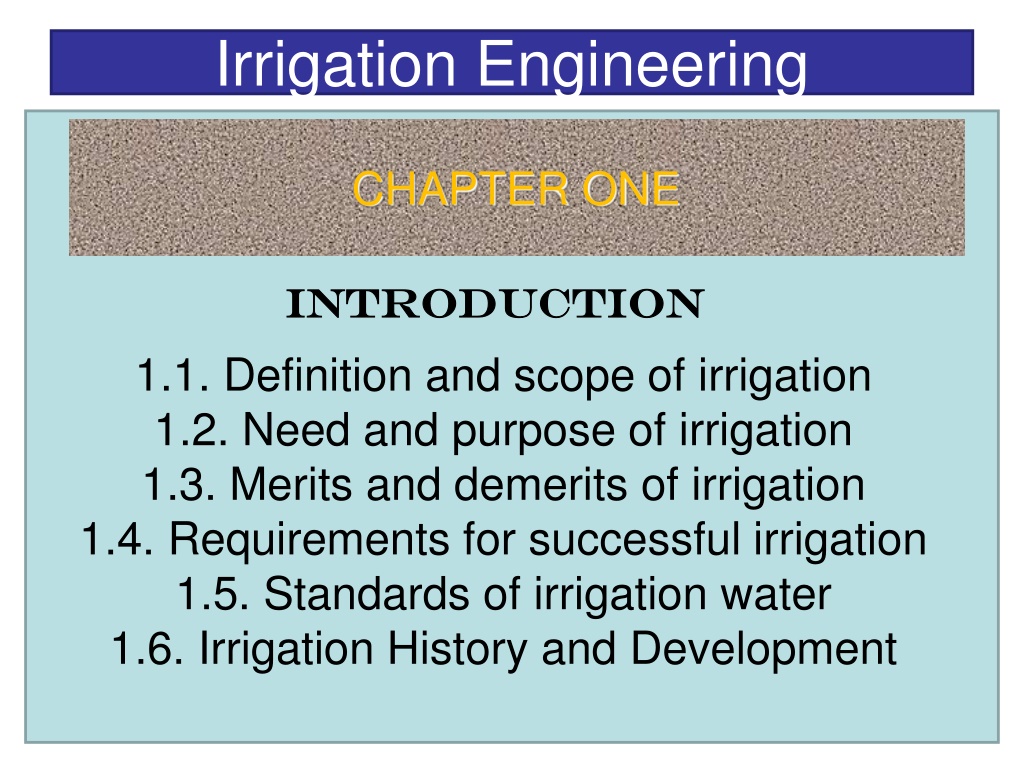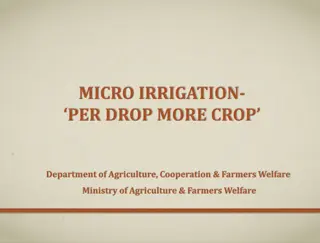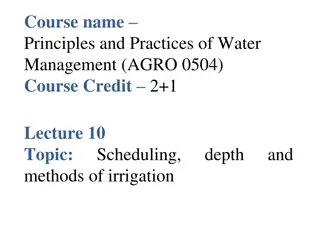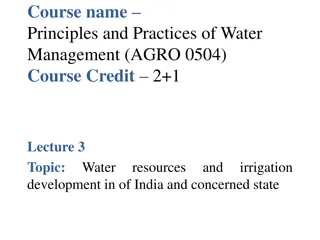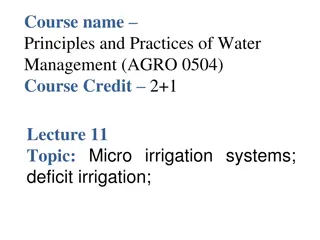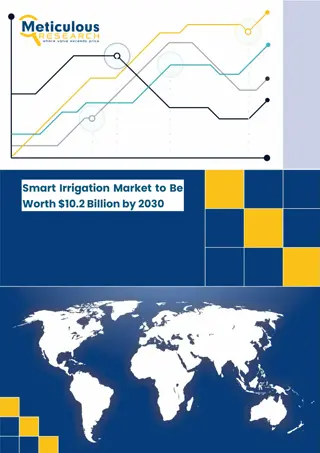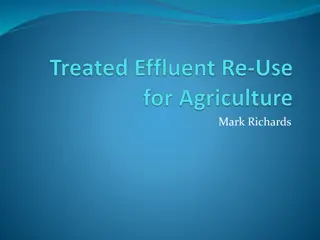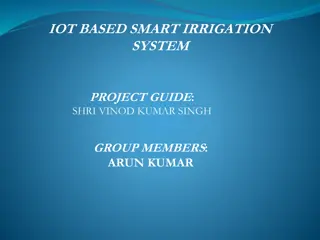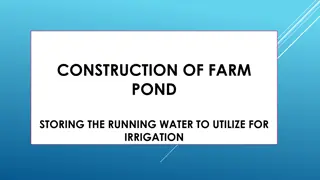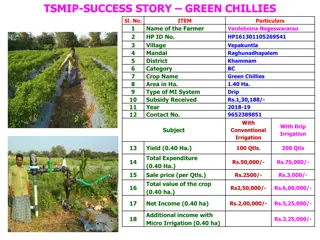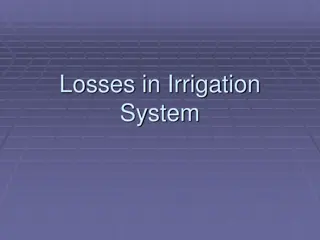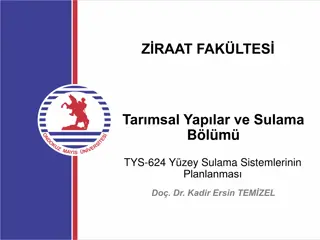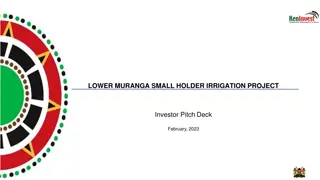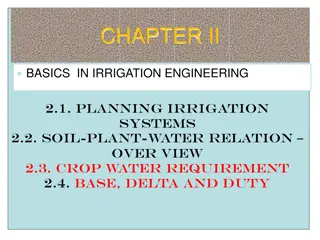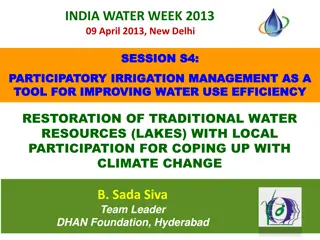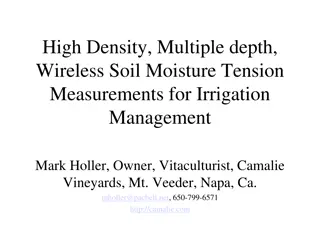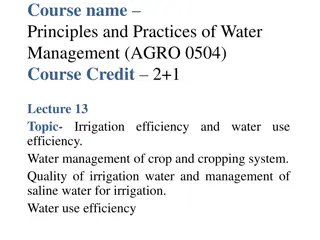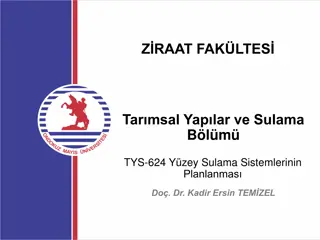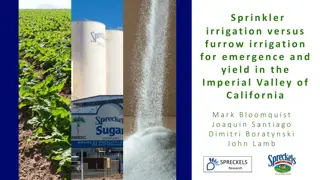Overview of Irrigation Engineering
Understanding the definition, scope, need, and purpose of irrigation in agriculture. Explore the merits, demerits, and requirements for successful irrigation. Learn about the history, development, and standards of irrigation water. Discover how irrigation plays a crucial role in crop production and the engineering aspects involved in ensuring a sustainable water supply for agriculture.
Download Presentation

Please find below an Image/Link to download the presentation.
The content on the website is provided AS IS for your information and personal use only. It may not be sold, licensed, or shared on other websites without obtaining consent from the author.If you encounter any issues during the download, it is possible that the publisher has removed the file from their server.
You are allowed to download the files provided on this website for personal or commercial use, subject to the condition that they are used lawfully. All files are the property of their respective owners.
The content on the website is provided AS IS for your information and personal use only. It may not be sold, licensed, or shared on other websites without obtaining consent from the author.
E N D
Presentation Transcript
Irrigation Engineering CHAPTER ONE Introduction Introduction 1.1. Definition and scope of irrigation 1.2. Need and purpose of irrigation 1.3. Merits and demerits of irrigation 1.4. Requirements for successful irrigation 1.5. Standards of irrigation water 1.6. Irrigation History and Development
1.1. Definition of irrigation Irrigation is any process, other than natural precipitation, which supplies water to crops for their successful growth. Irrigation is the artificial application of water to the soil to meet the crop water needs for its vegetative development and for production. is the science of artificial Irrigation application of water to the land, in accordance with the crop requirements throughout the crop period for full nourishment of the crops.
Definition of irrigation cont Irrigation is the application of water to the soil to supplement natural precipitation and provide an environment that is optimum for crop production. Or in different words is a science of survival for mankind It is the Engineering of controlling and harnessing the various natural sources of water, by construction of dams & reservoirs, canals & head works and finally distributing the water to agricultural fields.
1.2. Need and purpose of Irrigation: Irrigation is needed for a continuous and reliable water supply to the different crops in accordance with their different needs When water supply is not sufficient and timely, crop yield reduced and consequently famines and disasters. Thus, irrigation may be supplementary irrigation or total irrigation based on rainfall availability. Irrigation is needed in: Arid and semi-arid regions - natural rainfall does not provide all the water needed, and therefore, irrigation can make up this deficiency. Humid regions little doubt for the need but ideal rainfall patterns seldom occurs. The need of irrigation in humid regions is mainly to supplement the supply of water received from precipitation.
Need and purpose of Irrigation cont Generally the following are some of the factors that necessitate irrigation. inadequate rainfall uneven distribution of Rainfall increasing the yield of the crops growing a number of crops to insure against drought. to grow perennial crops.
purposes of Irrigation 1. Add water to soil to supply the moisture essential for plant growth. 2. Provide crop insurance duration droughts 3. Cool the soil and atmosphere, there by making more favorable environment for plant growth. 4. Reduce the hazard of frost against short 5. Wash out or dilutes salts in the soil
purposes of Irrigation cont 6. Reduce the hazard of soil piping 7. Soften tillage pans and clods 9. To enhance fertilizer application- Fertigation
1.3. Merits and demerits of Irrigation: Various direct and indirect advantages of irrigation. Merits: Increase in crop production: irrigation helps in increasing crop yield through controlled and timely supply of water to the crop Optimum benefits: Optimal utilization of water is made possible by irrigation optimum utilization of water, implies obtaining maximum crop yield with any amount of water. in other words yield will be smaller for any quantity lesser than or in excess of the optimal quantity irrigation helps to stabilize the farm economy irrigation can improve the quality of crops
Merits cont Elimination of mixed cropping: in areas where irrigation is not ensured, generally mixed cropping is adopted. Mixed cropping is sowing /growing two or more crops simultaneously in the same field. If the weather condition is not suitable to one of the crops it may be suitable for the other, and thus at least some yield is obtained. Mixed cropping can be adopted when irrigation facilities are not available, but if irrigation is assured it can be eliminated. Mixed cropping is generally not acceptable, because different crops require different types of field preparations and different types of manures, amount of water etc.
Merits cont Mixed cropping is thus necessary and economical when irrigation facilities are lacking. But if irrigation is assured, mixed cropping can be eliminated or reduced through irrigation, the time of harvest can be more closely controlled with irrigation, fertilizers placed in the soil are available at once to plants
Merits cont irrigation protects certain high value crops from frost damage/high temperature. irrigation increases transplanted crops Conjunctive use of irrigation projects hydroelectric power, domestic water supply General prosperity: Revenue returns are sometimes quite high and helps in all round development of the country the survival of
Merits cont Generation of hydroelectric power: cheaper power generation can be obtained on objects primarily designed for irrigation alone. Also falls on irrigation channels can be utilized to generate electricity industrializing the rural area and so in solving the problem of fuel shortage. Domestic water supply:- irrigation helps in augmenting the town water supply where water is available with great difficulty. It also provides water for swimming bathing, cattle drinking etc. which may help in
Merits cont Facilities of communication: Irrigation channels are generally embankments and inspection roads. provided with These inspection paths provide a good road way to the villagers for walking, cycling or even motoring. In land navigation
ILL-effects /demerits of irrigation ILL-effects of irrigation occur only when the scheme is not properly designed and implemented. if not properly managed, irrigation may result in the outbreak of water borne diseases and Salinity problem Most of these are due to excess irrigation water application. Some of the common ill-effects are:
ILL-effects /demerits of irrigation cont.. 1.Waterlogging when cultivators apply more water than actually required by the crops, excess water percolates in to the ground and raises the water table. Water logging occurs when the water table reaches near the root zones of the crops. The soil pores become fully saturated and the normal circulation of air in the root zones of the crop is stopped and the growth of the crops is decreased. Thus crop yield considerably reduces. When the water table reaches the ground surface, the land becomes saline.
ILL-effects /demerits of irrigation cont.. Ground water pollution through leaching of fertilizers Irrigation is relatively management is difficult. Long term application of pesticides under large scale irrigation system might have a negative influence on soil microbial activities, on the quality of surface and sub surface water resources and the survival of the surrounding vegetation. Irrigation may contribute in various ways to the problem of pollution. One of these is the seepage in to the ground of the nitrates that has been applied to the soil as fertilizer. expensive and the
ILL-effects /demerits of irrigation cont.. Sometimes up to 50% of the nitrates applied to the soil sink in to the underground reservoir. The under ground water thus get polluted. Irrigation may result in hot and damper climate causing outbreak of disease like malaria. Irrigation is complex and expensive in itself. Some times cheaper water is to be provided at the cost of the government and revenue returns are low.
1.4 Requirements for successful irrigation: a) Land Capability Irrigation should be confined to soils that are capable of producing sustained high yields of adapted crops b) Adequate Water Supply A supply of water adequate to meet the needs of the crops being irrigated must be available when needed. c) Adequate Labor Irrigation requires more labor than rain-fed agriculture. d) Climate The climate is a very important factor in any sort of cultivation e) Adequate Capital Enough initial capital to install, operate and maintain irrigation project is required. f) Others: Effective management of soil and water
1.5. standards of irrigation water Every water is not suitable for irrigation. The quality of irrigation water is very much influenced by: the continents of the soil, which is to be irrigated particular water may be harmful for irrigation on a particular soil But the same water may be tolerable or even useful on some other soil.
1.5. standards of irrigation water cont.. Irrigation water may unsatisfactory for its intended use if it contains: Chemicals toxic to plants or the persons using plant as food chemicals that react with the soil to produce unsatisfactory moisture characteristics Bacteria injurious to persons or animals eating plants irrigated with water. be said to be
Irrigation water unsuitability suitability Sediment: its effect depends upon the type of irrigated land when fine sediment from water is deposited on sandy soils the fertility is improved on the other hand if the sediment has been derived from the eroded areas it may reduce the fertility or decrease the soil permeability. Sediment water creates troubles in irrigation canals as it increases their siltation and maintenance costs. In general ground water or surface water from reservoirs, etc does not have sufficient sediment to cause any serious problems in irrigation.
Irrigation water unsatisfactory / Unsuitability cont. Irrigation water Salinity Two main causes of salinity: Salinity caused by the supply of irrigation water Salinity caused by the upward movement of water and salts, related to high water tables and lack of drainage; it is only indirectly related to salts in the irrigation water
Irrigation water unsuitability / suitability cont The general solution to these problems is to remove the salts from the soil by providing extra water, which dissolves the salts and percolates to the saturated zone. This process is called leaching. Where it is removed by drainage. This is one of the reasons why irrigation systems also require drainage systems.
Irrigation water unsuitability / suitability cont Total concentration of soluble salts: Salts, when present in excessive quantities, reduce osmotic activities of the plants and may prevent adequate aeration causing injuries to plant growth. The effect of salts on plant growth depends largely upon the total amount of salts in the soil solution. The salinity concentration of the soil solution (Cs) after the consumptive use (Cu) has been extracted from the soil is given by :
where, Q is quantity of water applied Cu is consumptive use of water i.e. the total amount of water used up by the plant for its growth. Peff is useful rainfall Cu-Peff is used up irrigation water C concentration of salt in irrigation water C*Q is the total salt applied to the soil with Q amount of water
salinity concentration Concentration of salt is measured in PPM (mg/l). Concentration of salt above 2000 PPM is generally harmful for almost all crops. Salt concentration is measured by determining electrical conductivity. Low Conductivity (low salinity)100-250 micromhos /cm Medium conductivity 250-750 micromhos/cm High conductivity 750-2250 micromhos/cm Very high conductivity >2250 micromhos at 250C
Proportion of sodium ions to other cations small quantities of sodium ions are present in most soils relative to other cations. If its percentage increases it has an influence on the aggregation of soil grains i.e. breaks down. The soil becomes less permeable and of poorer tilth. It starts crusting when dry and its PH increases towards that of an alkaline soil. High sodium soils are therefore, plastic, sticky when wet, and are prone to form clods and they crust on drying.
Sodium adsorption The proportion of sodium ions present in the soil is generally measured by a factor called sodium- absorption ratio (SAR) and represents the sodium hazards of water. SAR is defined as: Where the concentration of the ions is expressed in equivalent per million (epm). epm is obtained by dividing the concentration of salt in mg/l or PPM by its combining weight (i.e. atomic weight valence)
Sodium adsorption cont When SAR between 0-10 it is low sodium water 10-18 medium ,, 18-26 High ,, >26 very high ,, Low sodium water is suitable for irrigation except in crops, which are sensitive to sodium like fruit trees, avocados etc where as medium sodium water is hazardous in fine textured soils. Very high sodium water is generally not suitable for irrigation. SAR value can be reduced by adding gypsum (CaSO4)
Potentially toxic elements: Elements like Boron, Selenium, etc may be toxic to plants. Concentration of Boron exceeding 0.3 PPM may be toxic to certain plants. >0.5 PPM dangerous to nuts, citrus fruits. Dates, Beets, asparagus are quite tolerant. Even for the most tolerant crops its concentration should not exceed 4 PPM . Boron is present in various soaps. Wastewater containing soap, etc should be used with great care in irrigation. Guidelines for the interpretation of water quality for irrigation water (FAO,1976)
Irrigation problem No problem medium problem severe Salinity (affects water uptake Ecw (mmhose /cm) Permeability (affects water infiltration and availability (Ecw (mmhose /cm Adj. SAR Montimorilonite- Hlite Vermiculite Kaolinite- sesquixides < 0.75 0.75 to 3.0 >3.0 > 0.5 0.5 - 0.2 < 0.2 < 6 < 8 < 10 6 8 16 - 24 - 9 - 16 > 9 > 16 > 24 Specific ion toxicity(affects sensitive crops) Sodium (Adj.SAR) Chloride (meq./l) Boron (mg/l) < 3 < 4 0.75 3 - 9 4 - 10 0.75 - 12 >9 > 10 > 12 Miscellaneous effects (affects susceptible crops) NO3-N or NH4-N (mg/l) HCO3 (meq./l) PH < 5 < 1.5 5 1.5 - 8.5 Normal range - 30 30 >8.5 6.5 to 8.4
Problems in Irrigation Development Irrigation plays a significant role in the agricultural development of the country but there are still enormous constraints in its development. Lack of mapping data: Mapping information not available at a scale suitable for detailed studies of irrigation areas, dam sites, etc. Similarly, data related to soils are not found in sufficient detail to all potential areas. Lack of Hydrologic Data: The collection of hydro meteorological information are not adequate. River gauges are mostly available for major rivers and bigger tributaries. Lack of resources: The level of skilled manpower available in the country is not adequate to carry out the number of projects being demanded by the regions. Inadequacy in construction capability due to inadequate machinery, equipment and spare parts.
Problems in Irrigation Development .. Lack of Finance: Despite ambition plan of the government, sources of finance for implementing the planned irrigation projects is expected from foreign aid and loans. Inadequate research undertakings in the area: So far, little emphasis for irrigation in agricultural research. Operation and Maintenance: Institutional water operation and management is in a very poor condition with regard to the administration of supply, maintenance and repair of the networks due to lack of trained manpower, sufficient maintenance tools and equipment.
Irrigation engineering Irrigation Engineering is a broad-based science which deals not only with the application of water to the land but also with the planning and design of various structures required for an irrigation system Irrigation Engineering is not only confined to the application of water to the land for raising crops. It includes all aspects and problems extending from the watershed to the agricultural fields.
irrigation engineering cont It deals with: hydrology, river Engineering, the design and construction of dams, weirs, canals and various other hydraulic and irrigation structures. It also deals with: surface and sub surface drainage system, soil reclamation, water-soil crop relationships.
irrigation engineering cont It deals with the Harnessing of various natural water resources for irrigation and all aspects and problems starting from the watershed to the agricultural fields/ command areas Other allied sciences such as: flood control, hydropower, and inland navigation IRRIGATION Engineering. are also studied in
Various aspects of irrigation Engineering A) Water resources and hydrology aspect to locate various water sources and to study the hydrology of the region. This includes study of : meteorology, precipitation, stream flow, floods, river engineering, reservoirs and flood control.
Aspects of irrigation Engineering cont Information required while designing various irrigation structures are as follows The quantity of water that will be available at a reservoir site for storage. Maximum discharge at a river site. Reservoir capacity that ensures adequate Quantity of water for various purposes. Quantity of ground water which can be economically exploited
Aspects of irrigation Engineering cont B) Engineering Aspect - involves the development of a source of water for irrigation and construction irrigation structures. Dams and water power Engineering of various Diversion and Distribution structures Minor irrigation schemes (well, Tank / Pond, inundation Irrigation).
Aspects of irrigation Engineering cont C) Agricultural aspect Involves irrigation practice the study of agricultural Characteristics of the land. Crops Soils D) Management Aspect- deals with successful implementation and efficient management aspects and agricultural works of engineering
Scope of Irrigation Engineering IRRIGATION ENGINEERING: involves Conception, Planning, Design, Construction, Operation and Management of an irrigation system.
Scope of Irrigation Engineering cont. An irrigation engineer is one who has a long theoretical and practical training in: planning, design, construction, operation and management of irrigation systems.
To Understand Irrigation, One Needs Knowledge of: Basic Soil Science/Physics Plants Water Plant/Soil/Water Relations Hydraulics Hydrology General Engineering Principles
Assignment-I Irrigation History and Development
